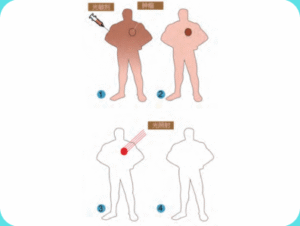Photodynamic Therapy
photodynamic therapy, or PDT, as its name suggests is a therapy that employs light, oxygen, and a photosensitizer to treat specific conditions. It has medical applications for treating certain tumors in the stomach and intestines, as well as bronchial tubes and other regions.
What is the procedure of photodynamic therapy?
The protocol initiates with the patient excitedly undergoing a photosensitizer injection via an intravenous line. As blood circulates throughout the body, the radioactive substance will localize to specially identified lesions of cancerous cells within the tumor. During this time, the patient must keep their eyes closed to avoid sun exposure.
In general, the protocol will keep the patient in a dark room until treatment, which is administered around 40 to 90 hours after the photosensitizer injection. Most patients are placed under general anesthesia. The tumor can be accessed using a gastroscope or colonoscope, through which red laser light of 630-nanometer wavelength is delivered via fiber optics. The photosensitizer is then activated and releases energy to the surrounding oxygen, producing reactive oxygen species. Subsequent to its formation, singlet oxygen will interact with the vicinity biomolecules, having a detrimental effect on cytotoxic tumor cells.

Formulate additional segments within the presentation as necessary. Keep in mind that for the whole procedure you should set an expectation of 30min to max 1 hr.. The patient should be regaining full consciousness at this time, although monitoring in the treatment area for an additional 30 minutes is required.After this, the patient can only be brought back to the ward if all vitals have returned to baseline and are stable. The activating light necessary for the majority of photosensitizers achieves a penetration depth of 7mm through tissue. Thus, once the necrotic tumor is removed, additional PDT will be required for tumors that are more than 7mm away.
Advantages
(1) No scarring
The employed techniques utilize endoscopic surgery or laser fiber cables. These instruments apply red laser light to the tumor, thereby eliminating the need for cuts or other forms of surgical trauma.
(2) Non-invasive
Because PDT focuses mostly on the illuminated portion of the tumor, as noted above, only a small fraction of adjacent healthy tissue is sacrificed. Moreover, a certain amount of photosensitizer requires exposure to red laser light for a specific time to produce its effect, thus triggering photodynamic action.
(3) Unlimited access to as many treatments as needed..
The low resistance tumor cells have against photosensitizers, alongside the lower rate of bodily toxic reactions, PDT can be used multiple times.
(4) Helps manage symptoms for advanced cancer.
Patients with cancer, chronic conditions of the heart, lungs, liver and kidneys, hemophilia or those above a certain age often shift their primary goal from curing an illness to symptom relief and improving quality of life along with life expectancy.Palliative therapies using PDT can be offered for this goal.
(5) Synergistic effect.
PDT may be utilized in conjunction with certain surgical procedures for specific types of tumors. Purpose of Excision Therapy: To successfully eliminate any remaining cancerous cells to lower risk of tumor recurrence. For other tumor types, PDT is used as the initial treatment, followed by surgical intervention to improve the likelihood of successful surgical outcomes.
